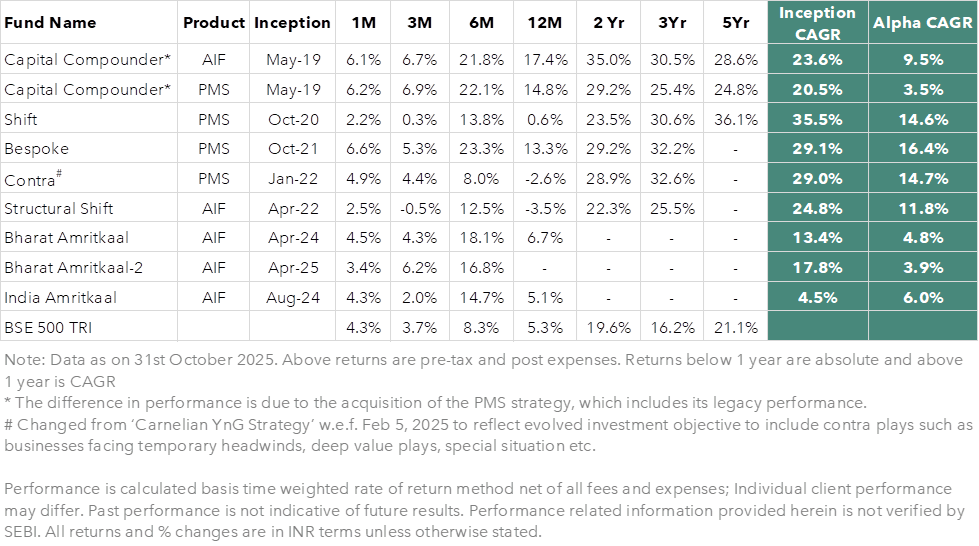Greetings from Team Carnelian!!
Carnelian strategies performance at a glance…

Morgan Housel, author on behavior finance says in his book, “An optimist sounds like a salesperson, and a pessimist tends to sound like a concerned well-wisher”.
On a personal note, I was authoring a book in 2015 “This time it’s different”, detailing our hypotheses and views on the Indian economy and markets. As you might have guessed, the underlying tone was very positive and optimistic. When I showed it to the editor of a leading newspaper, his only feedback was: “Write something negative as well—it will look more credible!”
It’s interesting how credibility is often not associated with optimism. Morgan’s sarcasm and this very incident—highlight how deep rooted this psychological bias is and remains. We have observed the same tendency in our interactions with investors, as we have always belonged to the optimist camp. In fact, as an extension to this, we’ve also observed that investors tend to perceive optimists as oblivious or blind to risk, while viewing pessimists as intellectual, grounded in reality, and risk aware.
In this letter, we aim to present our views on the interesting subject of “An optimist’s take on managing risk.” Let’s first understand why the optimist’s approach is often misunderstood and misjudged:
Bias toward pessimism: Pessimism sells. Morgan’s book has an interesting chapter titled “The seduction of pessimism” outlining this beautifully. Due to our evolutionary wiring, humans tend to focus more on threats than on opportunities, as survival has always depended on recognizing dangers quickly. That’s why a report titled “Markets Will Fall 50%” would attract far more readership and attention than one that says, “Markets Will Rise 100%.”
Visible Confidence: An optimist’s enthusiasm and positive framing are often mistaken for overconfidence or a lack of seriousness. Their willingness to “bet big” can appear reckless to those who prioritize caution.
Misinterpreting Resilience: An optimist’s ability to shrug off failure or pivot quickly is sometimes misconstrued as indifference to consequences. In reality, it reflects a deliberate mindset rooted in growth and adaptability.
Lack of Visible Worry: Optimists rarely dwell on risks publicly, which can make them seem casual or unconcerned. Their internal process—assessing risks carefully while remaining focused on solutions—is less visible, often leading to assumptions of carelessness.
How this bias influences investing decisions and outcomes:
Poor asset allocation:
Despite having long-term capital, many investors shy away from taking appropriate risks to avoid short-term drawdowns. In doing so, they often miss significant opportunities—allocating long-term funds to low-yielding assets that may not even beat inflation.
Excessive short-term reactions:
This bias drives investors to react to every piece of market noise, frequently entering and exiting positions. For instance, we observed many investors reducing exposure in April 2025, only to buy back at higher levels later.
Constant worry and lack of joy:
Investing should be a rewarding, long-term journey. However, many investors remain anxious and paranoid, letting short-term news affect their long-term outlook. The most common question we hear is, “What’s your view on the markets?”—a reflection of this short-term anxiety.
Inability to hold on to winners:
Many investors struggle to stay invested in successful positions for long, often booking profits too early and missing out on potential multibaggers.
How does optimist take and manage risk?
As Winston Churchill once said, “A pessimist sees the difficulty in every opportunity; an optimist sees the opportunity in every difficulty.” These two mindsets shape how people face challenges, make decisions, and respond to change.
Being optimistic doesn’t mean ignoring risks or managing them casually. Rather, optimists have a distinct and often misunderstood framework for assessing and handling risk. Below, we outline how optimists perceive risk, the structure of their approach, and why it’s sometimes mistaken for risk ignorance.
An optimist’s approach to risk isn’t reckless—it’s structured, adaptive, and grounded in long-term thinking. Let’s delve deeper into this perspective.
How an Optimist Sees Risk
These traits make optimist investors more resilient and adaptable in uncertain environments. Rather than being paralyzed by failure, they analyze what went wrong, adjust their strategies, and try again with better insight. This positive interpretation of loss fuels their willingness to take calculated risks, distinguishing them from reckless speculators.
The legendary Rakesh Jhunjhunwala epitomized the optimist investor. He was a man of his own conviction, never shying away from high-conviction calls. He leveraged when he was confident, cut positions emotionlessly when proven wrong, and held investments for decades, creating 100+ baggers. Some of his quotes reflect this mindset:
In essence, optimism transforms risk from something to avoid into something to manage and leverage. It shifts the focus from fear of loss to pursuit of possibility. The modern world rewards those who not only protect capital but also seize potential—those who, in every setback, see the seed of the next great opportunity.
To conclude, optimists see risk as a doorway to possibility, guided by a structured yet hopeful framework. Their approach is often misunderstood because it contrasts with conventional caution—but true optimism is far from casual. It is a deliberate, resilient strategy for navigating uncertainty and turning challenges into opportunities.
At Carnelian, we have consistently navigated the ever-changing market landscape with optimism anchored in research and discipline, maintaining a sharp focus on risk within our defined risk–reward framework. We believe that informed optimism—not blind hope—is the cornerstone of long-term wealth creation.
We are acutely aware that, at times, our informed optimism may be perceived as a lack of focus on risk. Yet, we will always choose to pursue our strong convictions with clarity, rather than hedge or soften our stance to appear “more credible.”